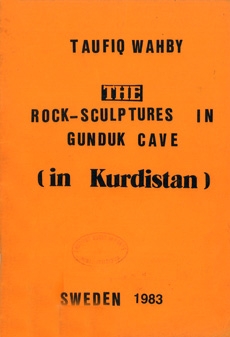|
FORWORD
By Seton Lloyd, F. S. A.
A new set of photographs, recording in detail the two groups of sculptured reliefs at Gunduk in North Iraq, were obtained by the Directorate-General of Antiquities in the Autumn of 1947. Prompted by these, H.E. Sayyid Tawfiq Wahbi, has written the following interesting notes on the possible implications of these rock-carvings, whose date and general significance have till now remained remained enigmatic.
His Excellency, who has for many years shown signs of the most active interest in the social anthropology as well as the antiquities of the northern liwas, has suggested an interpretation of their function and symbolism which will be seen by archaeologists to merit serious consideration He has in fact associated the purpose of the sculptures with primitive superstition of the kind defned by Sir James Frazer as homoeopathic magic,' and has elaborated his contention by the enumeration and description of some pertinent rituals practised by the Kurds of the present day. These in themselves are of great interest, as so little research of an anthropological character has, till now, been achieved among the Kurdish people. Those familiar with the subject will have no difficulty in recognizing some old fertility rituals in a new form, while his rain ceremonies make an interesting comparison with that recorded at Khorsabad by Franfort (Iraq Vol. 1 No. 1).
His Excellency's identification of the various figures in the first sculptured group, does not always agree with those of previous visitors to the site, but their state of preservation makes some speculation permissible. As to the dating of the carvings, some caution is necessary in accepting the inference that one of the two groups belongs to a period when agriculture was in its infacy; and one would be more inclined, like Bachmann, to suspect that excavations in the mound adjoining the sculptures would reveal traces of an historic period to which both groups could be more safely attributed.
The Rock-Sculptures in Gunduk Cave
By H. E. Taufiq Wahby
In the Autumn of 1947 the Directorate-General of Antiquities inaugurated its winter-season of research by visiting and recording photographically the principal rock-sculptures of North Iraq, including some reliefs never previously studied. Among the monuments are the two interesting groups of carvings near the village of Gunduk in the Aqra district (See mop No. 1). It is on the subject of these sculptures and their general implications that I have written the following notes, as o preliminary to their further study.
In the Gunduk cave (Plate 1) there are two groups of bas-reliefs. The first group is on the left of the cave as one approaches, and the second is about seven metres higher, to the right of the first (Plate 2).
Of these two groups, the first, (Plate 3), only, has been observed by the various archaeologists who visited the site in the past.
Sir A.H. Layard who visited the cave in 1850 and published a drawing of the first group of bas-reliefs in his book Nineveh and Babylon (1) has the following to say about :
"There are two sculptured tablets (Plate 4) in the rocks Gunduk. They have been carved at the mouth of a spacious natural cavern, whose roof is fretted with stalactites, and down whose sides trickles cool clear water, and hang dank ferns and creeping plants. It is called Guppa d'Mar Vohanna, or the cure of St. John, and near it is an ancient Nestorian church dedicated to Soint Audishio. The bas-reliefs are Assyrian. The upper represents a man slaying a wild goat with a spear. In the lower, as for as I could distinguish the sculpture, which is high on the rock and much injured, are women facing each other, and seated on stools.
Each holds a child above a kind of basin or circular ves'el, as if in the act of baptizing it. Behind the seated female to the left, a figure bears a third child, and is followed by a woman. On the opposite side is a group of three persons, apparently sacrificing an animal. There are no traces of inscriptions on or near the tablets."
…..
(1) Layard: Nineveh and Babylon. P. 368.
| 